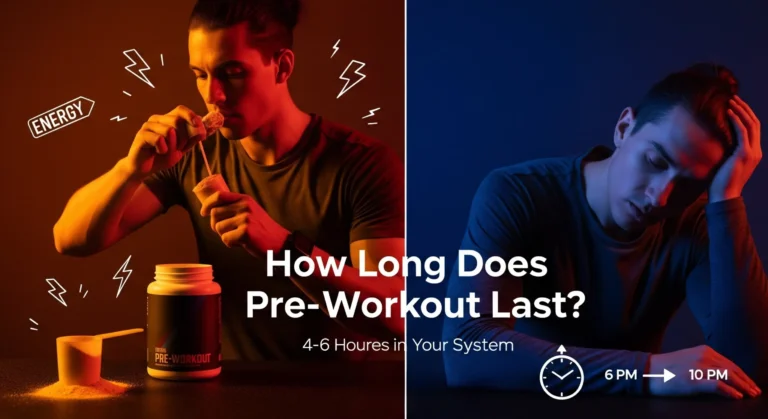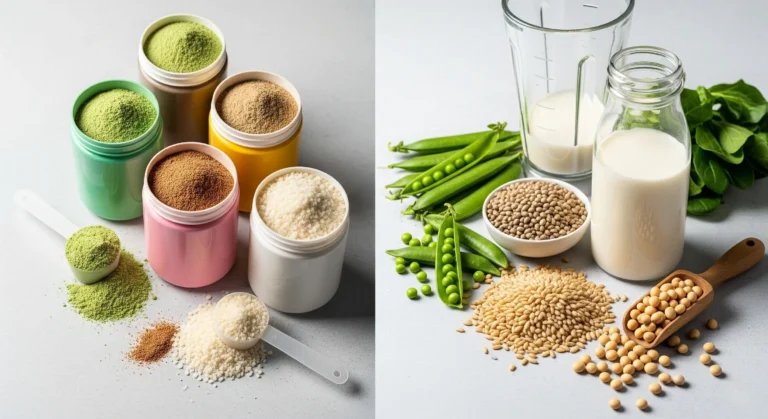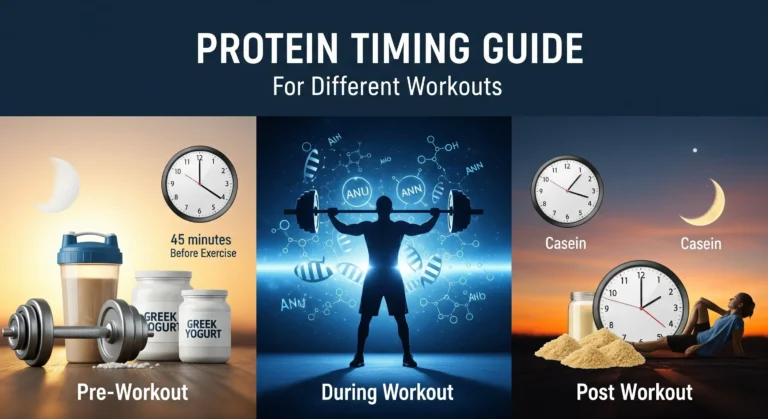
Ever stood in the supplement aisle, completely overwhelmed by protein powders claiming to be “superior quality” or “the best protein on earth”? I’ve been there too, staring at labels that might as well have been written in ancient Greek. Here’s a wild stat that’ll blow your mind: 73% of people buying protein supplements have absolutely no clue what makes one protein better than another!
That’s where I learned about PDCAAS the hard way. After wasting hundreds of dollars on “premium” proteins that were basically expensive rice water, I dove deep into protein science. What I discovered changed everything about how I choose my protein sources.
PDCAAS isn’t just some boring scientific acronym – it’s your secret weapon for cutting through marketing BS and finding proteins that actually work. Whether you’re trying to build muscle, lose weight, or just eat healthier, understanding protein quality scores will save you time, money, and frustration. Trust me on this one!
What is PDCAAS and Why Should You Care?
Okay, let’s break this down without getting too nerdy. PDCAAS stands for Protein Digestibility Corrected Amino Acid Score, and honestly, I wish they’d given it a catchier name!
Think of PDCAAS like a report card for protein. Just like how your old math teacher graded tests from 0 to 100, scientists grade proteins from 0 to 1.0 based on two main things: how well your body can digest the protein, and whether it contains all the amino acids you actually need.
I remember the first time my trainer explained this to me at the gym. He said, “Look, you can eat 50 grams of protein, but if your body can only use 20 grams of it, you’re basically throwing money down the toilet.” That hit home because I was spending a fortune on supplements back then.
The PDCAAS system was developed back in 1989 by some really smart food scientists who got tired of people making wild claims about protein quality. Before PDCAAS, companies could basically say whatever they wanted about their protein products. Now we’ve got a standardized way to measure what actually matters.
Here’s why this stuff matters more than you might think. Your body needs 20 different amino acids to function properly, but it can only make 11 of them on its own. The other 9 – called essential amino acids – have to come from food. If a protein source is missing even one of these essential amino acids, or doesn’t have enough of them, your body can’t use that protein efficiently.
It’s like trying to build a house but you’re missing screws. You might have all the wood and nails in the world, but without those screws, you’re not building anything sturdy. That’s exactly what happens when you eat low-quality protein sources.
The digestibility part is equally important. Some proteins look great on paper but your body struggles to break them down and absorb them. I learned this lesson the hard way when I tried going full vegetarian for a few months. I was eating tons of beans and thinking I was getting plenty of protein, but I felt tired and wasn’t recovering well from workouts. Turns out, plant proteins generally have lower digestibility scores than animal proteins.
Breaking Down the PDCAAS Scale (0 to 1.0)
The PDCAAS scale is actually pretty straightforward once you understand the basics. Think of it like a percentage, but instead of going from 0 to 100, it goes from 0 to 1.0. A score of 1.0 means the protein is considered “perfect” – your body can digest it well and it contains all essential amino acids in the right proportions.
When I first started tracking this stuff, I made a simple rule: anything above 0.7 was decent, anything above 0.9 was excellent, and 1.0 was the gold standard. This helped me make quick decisions in the grocery store without getting bogged down in the details.
Here’s where it gets interesting though. A protein gets its PDCAAS score based on its “limiting amino acid” – basically, whichever essential amino acid it has the least of. It’s like that old saying about a chain being only as strong as its weakest link.
For example, wheat protein has decent amounts of most amino acids, but it’s really low in lysine. So even though wheat has plenty of other amino acids, its PDCAAS score gets dragged down because of that lysine deficiency. The score reflects how well your body can actually use that protein for important stuff like building muscle and repairing tissues.
I used to think that complete proteins were just marketing hype until I started paying attention to how different proteins affected my recovery. Complete proteins – those with PDCAAS scores of 1.0 – contain all essential amino acids in proportions that match what your body actually needs. These are your heavy hitters: eggs, milk, whey, casein, and most animal proteins.
Incomplete proteins, on the other hand, are missing one or more essential amino acids or don’t have enough of them. Most plant proteins fall into this category, but here’s the cool part – you can combine incomplete proteins to create a complete amino acid profile. Rice and beans is the classic example that nutritionists love to talk about.
The tricky part is that PDCAAS scores can be misleading if you don’t understand the context. A protein might score 0.5, but if you eat twice as much of it, you might end up with better amino acid coverage than eating a smaller amount of a 1.0-scored protein. This is why I always tell people that PDCAAS is just one tool in the toolbox, not the final word on protein quality.
Top Protein Sources Ranked by PDCAAS Score
Let me share the protein quality rankings that completely changed how I shop for food. These scores come from years of scientific research, and I’ve organized them from highest to lowest to make your life easier.
The perfect 1.0 club includes some proteins you’d expect and maybe a few surprises. Whey protein isolate, casein, egg whites, and whole eggs all score a perfect 1.0. What shocked me when I first learned this was that milk protein also gets a 1.0 – I’d been avoiding dairy thinking it was somehow inferior to expensive protein powders!
Beef, chicken, fish, and turkey all score between 0.9 and 1.0, which is why bodybuilders have been obsessing over chicken breasts for decades. They weren’t wrong about the protein quality, even if their meal prep got a little boring.
Soy protein isolate also hits that perfect 1.0 score, making it the plant protein champion. This was a game-changer for my vegetarian friends who thought they couldn’t get complete proteins from plants. Regular soybeans score around 0.9, which is still fantastic.
Now here’s where things get interesting with plant proteins. Pea protein scores around 0.69, hemp protein comes in at about 0.46, and rice protein sits at around 0.42. These numbers used to discourage me from plant proteins until I learned about protein combining.
Quinoa surprised everyone by scoring around 0.73, making it one of the highest-scoring plant proteins. Amaranth and buckwheat also score higher than most people expect. I started incorporating these into my meals after learning their scores, and honestly, they taste way better than I thought they would.
The lower-scoring proteins aren’t necessarily bad – they just need some strategic pairing. Wheat protein scores about 0.25 because it’s low in lysine, but combine it with legumes (which are high in lysine but low in methionine), and you’ve got yourself a complete protein profile.
Here’s a pro tip I learned from a sports nutritionist: don’t get too hung up on individual meal PDCAAS scores. Your body pools amino acids throughout the day, so eating a variety of protein sources usually takes care of any deficiencies. I used to stress about getting perfect proteins at every meal, but now I just make sure my daily intake covers all the bases.
One thing that really opened my eyes was learning that many protein powders blend different sources to improve their overall PDCAAS score. That’s why you’ll see products mixing whey with casein, or pea protein with rice protein. The manufacturers aren’t just trying to cut costs – they’re actually creating better amino acid profiles.
PDCAAS vs Other Protein Quality Methods
When I first started researching protein quality, I got completely confused by all the different measurement methods floating around. PDCAAS, BV, PER, DIAAS – it felt like alphabet soup! Let me break down the main ones so you don’t have to go through the same headache I did.
Biological Value (BV) was one of the original protein quality measurements, and you still see it on some supplement labels. BV measures how much of the protein your body actually retains versus what you consume. Eggs score 100 on the BV scale, which is why old-school bodybuilders were obsessed with egg whites. The problem with BV is that it doesn’t account for digestibility – a protein might have great amino acid ratios but be hard for your body to break down.
I remember getting really excited about a protein powder that claimed a BV of 104 (higher than eggs!), only to find out later that the testing was done under pretty artificial conditions. BV studies typically use purified proteins and measure nitrogen retention over short periods, which doesn’t really reflect how we eat in real life.
Protein Efficiency Ratio (PER) is even older than BV – we’re talking 1919 old! It measures how much weight young rats gain per gram of protein consumed. Yeah, you read that right – rat studies. The obvious problem is that rat nutritional needs aren’t exactly the same as human needs. Casein scores super high on PER tests, but that doesn’t necessarily mean it’s the best protein for human athletes.
Now here’s where things get really interesting. DIAAS (Digestible Indispensable Amino Acid Score) is the newer kid on the block, introduced around 2013. The Food and Agriculture Organization actually recommends DIAAS over PDCAAS now, but most supplement companies are still stuck in the PDCAAS era.
The main difference is that DIAAS measures amino acid digestibility at the end of the small intestine (where absorption actually happens), while PDCAAS measures it based on fecal protein content. I know, gross, but it matters! DIAAS gives a more accurate picture of what your body actually absorbs and uses.
What really blew my mind was learning that some proteins score differently on DIAAS versus PDCAAS. Milk proteins tend to score even higher on DIAAS, while some plant proteins that looked decent on PDCAAS don’t fare as well when measured by DIAAS standards.
The frustrating part is that DIAAS testing is more expensive and complex, so you won’t find DIAAS scores on most supplement labels yet. Most of the research is still being done in academic settings. For now, PDCAAS remains the most practical tool for consumers, even though it’s not perfect.
Here’s my take after diving deep into all these methods: they’re all useful, but none of them tell the complete story. PDCAAS is still the most accessible and widely used, so it’s a good starting point. But don’t treat any single score as gospel – consider your overall diet, your specific goals, and how different proteins make you feel.
Common PDCAAS Myths and Misconceptions
Let me bust some myths that had me confused for way too long. The biggest misconception I see everywhere is that higher PDCAAS scores are always better, no matter what. That’s like saying a Ferrari is always better than a Honda – it depends on what you’re trying to do!
I used to think that if whey protein scored 1.0 and pea protein scored 0.69, I should only eat whey protein. But here’s the thing – if you eat 50 grams of pea protein versus 30 grams of whey protein, you might actually end up with better overall amino acid coverage from the pea protein. The total amount matters just as much as the quality score.
Another myth that drove me crazy was the idea that plant proteins are automatically inferior because of their PDCAAS scores. Yeah, most individual plant proteins score lower than animal proteins, but that doesn’t make them useless. I know plenty of vegan athletes who are absolutely jacked, and they’re not all secretly eating meat!
The key is protein combining, which is something our ancestors figured out thousands of years ago without knowing anything about PDCAAS. Rice and beans, hummus and pita, peanut butter and whole grain bread – these classic combinations work because they complement each other’s amino acid profiles.
Here’s a myth that supplement companies love to perpetuate: that you need to buy expensive protein blends to get complete amino acid profiles. I fell for this hard in my early supplement days, spending extra money on “scientifically formulated” protein blends that were supposedly superior to single-source proteins.
The truth is, if you’re eating a varied diet with multiple protein sources throughout the day, your body will pool those amino acids and use them as needed. You don’t need to stress about getting perfect amino acid ratios at every single meal. Your liver is like a smart warehouse manager – it stores and distributes amino acids as your body needs them.
One myth that really gets my goat is when people say PDCAAS doesn’t matter for muscle building because “bodybuilders didn’t know about it back in the day.” That’s like saying we shouldn’t use GPS because explorers used to navigate by the stars. Just because something worked doesn’t mean we can’t do it better with more knowledge.
The opposite extreme is just as bad though – people who obsess over PDCAAS scores and ignore everything else about their diet. I’ve seen folks eat nothing but whey protein and chicken breast because those score 1.0, while completely ignoring vegetables, healthy fats, and carbohydrates. Your body needs more than just high-quality protein to function properly.
There’s also this weird myth that PDCAAS scores change depending on how you prepare the food. Cooking methods can affect protein digestibility to some extent, but the actual amino acid profile doesn’t magically transform because you grilled your chicken instead of baking it. The PDCAAS score stays relatively consistent regardless of preparation method.
How to Use PDCAAS Scores for Your Fitness Goals
Now let’s get practical about how to actually use this information. When I first learned about PDCAAS, I made the mistake of trying to optimize every single meal, which turned eating into a math problem. Don’t do what I did – use PDCAAS as a guide, not a rigid rule.
For muscle building, PDCAAS scores matter more than for general health. When you’re trying to maximize muscle protein synthesis, getting complete amino acid profiles becomes crucial. This is why whey protein became so popular with bodybuilders – that 1.0 PDCAAS score plus fast absorption makes it ideal for post-workout nutrition.
But here’s what I learned the hard way: timing matters as much as quality. Having a perfect PDCAAS score doesn’t help much if you’re not eating enough total protein throughout the day. I used to drink a whey shake after workouts and think I was golden, while barely hitting 0.8 grams per pound of body weight daily. No wonder my progress was slow!
For weight loss, PDCAAS becomes interesting in a different way. Higher quality proteins tend to be more satiating, which means you feel full longer and are less likely to overeat. Eggs are a perfect example – they score 1.0 on PDCAAS and consistently rank as one of the most filling foods in satiety studies.
I noticed this personally when I switched from cereal for breakfast to eggs. The cereal had decent protein content on paper, but I’d be hungry again within two hours. Three eggs kept me satisfied until lunch, and I naturally started eating less throughout the day.
Plant-based eaters need to be more strategic with PDCAAS scores, but it’s totally doable. The key is complementary proteins – combining incomplete proteins to create complete amino acid profiles. I helped my vegetarian sister figure this out, and now she’s stronger than she’s ever been.
Some winning plant protein combinations: lentils with rice, hemp seeds with quinoa, or pea protein powder mixed with almond butter. You don’t need to eat these combinations in the same meal either – your body pools amino acids throughout the day.
For endurance athletes, PDCAAS matters less than total protein intake and timing. Long-distance runners and cyclists need adequate protein for recovery, but they’re not trying to maximize muscle protein synthesis like bodybuilders. A mix of high and moderate PDCAAS proteins usually works fine.
Here’s a practical approach I use now: aim for at least one high-PDCAAS protein (0.9 or above) per day, make sure you’re hitting your overall protein targets, and don’t stress too much about the rest. If you’re eating a varied diet with both animal and plant proteins, you’re probably doing fine.
One last tip that saved me tons of money: don’t automatically assume higher PDCAAS means higher price. Eggs, milk, and canned fish often offer better value than expensive protein powders, even though they have identical or similar PDCAAS scores.
Conclusion
Here’s the bottom line after years of experimenting with different proteins and diving deep into the research: PDCAAS is a useful tool, but it’s not the be-all and end-all of protein selection. Think of it like the nutritional equivalent of a car’s horsepower rating – important information, but not the only thing that matters.
The most important takeaway is that protein quality does matter, especially if you’re trying to build muscle or maintain muscle while losing weight. But total protein intake, timing, and overall diet quality matter just as much, if not more. I’ve seen people obsess over PDCAAS scores while eating 50 grams of protein per day and wondering why they’re not seeing results.
My advice? Use PDCAAS as a tiebreaker when choosing between protein sources, but don’t let it paralyze you with analysis. If you’re eating a variety of protein sources throughout the day and hitting your total protein targets, you’re already ahead of 90% of people.
Remember that your individual needs matter more than any scientific score. Some people digest certain proteins better than others, regardless of PDCAAS ratings. Pay attention to how different proteins make you feel, how well you recover from workouts, and whether you’re making progress toward your goals.
The supplement industry will keep pushing the latest and greatest protein innovations, but the fundamentals haven’t changed. Quality protein sources – whether they score 0.7 or 1.0 on PDCAAS – combined with consistent training and adequate rest will get you where you want to go.
What’s your experience been with different protein sources? Have you noticed differences in how various proteins affect your energy, recovery, or results? Drop a comment below and share your insights – I love hearing about what works for different people in the real world!



